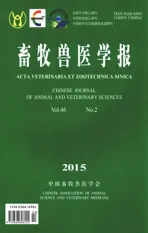PGP9.5和神经肽Y在双峰驼正常睾丸和隐睾的分布比较
2015-03-22袁莉刚闫振龙陶金忠陈国娟
袁莉刚,闫振龙,陶金忠,刘 英,陈国娟
(1.甘肃农业大学动物医学院,兰州 730070 ;2.甘肃农业大学生命科学技术学院,兰州 730070;3.宁夏大学 动物医学院,银川 750021)
PGP9.5和神经肽Y在双峰驼正常睾丸和隐睾的分布比较
袁莉刚1*,闫振龙2,陶金忠3,刘 英1*,陈国娟1
(1.甘肃农业大学动物医学院,兰州 730070 ;2.甘肃农业大学生命科学技术学院,兰州 730070;3.宁夏大学 动物医学院,银川 750021)
探讨PGP9.5和神经肽Y在双峰驼正常睾丸和隐睾的表达及在精子发生中的作用机制。采集性成熟未交配2~3岁成年双峰驼正常睾丸及隐睾,应用免疫组织化学SP法检测PGP9.5和神经肽Y在睾丸的定位,并通过图像分析技术进行定量分析。结果表明:PGP9.5在正常睾丸支持细胞、各级生精细胞和动静脉血管都有高密度阳性反应;神经肽Y在支持细胞呈中等阳性,各级生精细胞和动静脉血管呈弱阳性,隐睾组中PGP9.5和神经肽Y表达位置相似于正常组,但表达量显著降低。PGP9.5和神经肽Y在正常组和隐睾组Leydig细胞表达无差异,均为强阳性。可见PGP9.5及神经肽Y参与了双峰驼正常睾丸和隐睾生精功能的调节,二者通过支持细胞及管周肌样细胞对于隐睾生精微环境的调控能力降低,但隐睾内间质细胞的分泌并未受明显影响。本研究为进一步研究双峰驼睾丸神经递质变化与隐睾症发生关系及调控机制提供了参考。
双峰驼;隐睾;PGP9.5;神经肽Y;免疫组织化学
哺乳动物睾丸功能主要受到交感神经和局部激素分泌的调节。蛋白基因产物9.5(protein gene product,PGP 9.5)由212个氨基酸组成,相对分子质量27 ku,作为一种泛神经标记物广泛表达于神经元分化的各个阶段,应用于器官和组织的发病机制和诊断研究[1]。神经肽Y(neuropeptide Y,NPY)由36个氨基酸组成,是神经系统中最丰富的短肽,具有参与激素分泌,调节生长发育、性行为等生物学功能[2]。研究表明,神经肽Y通过参与调控下丘脑—促性腺激素释放激素(gonadotropin-releasing hormone,GnRH) 和垂体促性腺激素(Pituitary-gonadotropin)的释放,调节睾丸生理功能。国内外研究显示,PGP9.5和神经肽Y在人、猪、驴、单峰驼等哺乳动物睾丸内有显著分布,在睾丸正常生理功能方面发挥着重要的调节作用[3-6]。哺乳动物下丘脑—垂体—睾丸内分泌轴和睾丸组织局部自分泌及旁分泌调节系统参与精子发生调控,睾丸受胆碱能神经、去甲肾上腺素能神经和肽能神经支配,神经递质水平变化对正常生精过程必不可少,且与不育症发生关系密切[7-8]。双峰驼为中国遗传资源保护品种,目前关于双峰驼隐睾神经调控未见报道。本研究通过双峰驼睾丸内PGP9.5和神经肽Y分布比较正常睾丸与隐睾内神经递质的分布变化,对双峰驼遗传资源保护以及从神经方面治疗隐睾症具有重要意义。
1 材料与方法
1.1 材料与试剂
2012年12月,自宁夏回族自治区吴忠市涝河桥清真牛羊肉批发市场,采集健康性成熟未交配2~3岁双峰驼。经颈部放血致死后立即采集睾丸组织标本,共20例,其中正常睾丸14例,隐睾6例。以4%中性甲醛溶液固定3 d后,制作石蜡切片,常规染色、观察。正常组选择组织结构发育良好的睾丸;隐睾组选择结构典型的归为一组,进一步分别进行免疫组织化学研究。NPY兔抗鼠多克隆抗体(bs-0071R)和PGP9.5兔抗鼠多克隆抗体(bs-3806R)购自北京博奥森生物技术有限公司;免疫组化染色试剂盒(sp-0023,由美国ZYMED公司生产)购自北京博奥森生物技术有限公司;DAB显色试剂盒(ZLI-9018)和APES防脱玻片(ZLI-9502)购自北京中杉金桥生物技术有限公司。
1.2 方法
采用免疫组织化学SP法进行染色,NPY和PGP9.5两种多克隆抗体均1∶400稀释后使用。阴性对照组用0.01 mol·L-1的PBS代替一抗(NPY和PGP9.5)。用OlympusDP71显微镜进行观察并照相。
1.3 图像分析
光镜下观察免疫组织化学切片,每组切片中随机选取5张,在400倍和1 000倍显微镜下进行拍照,对400倍照片用DP软件采集5个视野,首先参照A.M.Suburo等[9]采用半定量的形式对染色结果的分布密度进行描述,-,无阳性表达;+/-,偶有阳性表达;+,阳性表达;++,中等强度阳性表达;+++,强阳性表达;++++,高密度强阳性。然后用Image-Pro Plus6.0软件进行图像分析,测定阳性反应物的平均光密度,用SAS(1996)统计软件中GLM模型,以ANOVA方法对数据进行分析。若各处理间差异显著,则用Duncan’s多重比较进行检验。结果用最小二乘法的均值及平均标准误表示,P<0.05为差异显著,P<0.01为差异极显著。
2 结 果
PGP9.5和神经肽Y在双峰驼正常睾丸和隐睾表达的免疫组织化学染色见图1、2。
2.1 PGP9.5在双峰驼正常睾丸和隐睾的定位及分布特点
双峰驼正常睾丸组织中PGP9.5肽能神经分布广泛,结果显示血管周围、睾丸间质、曲精小管以及周边均有不同程度分布(图1a、b、c)。PGP9.5在支持细胞为高密度强阳性,精原细胞为强阳性,初级精母细胞和精子细胞为高密度强阳性,偶有中等阳性,管周肌样细胞为中等阳性,Leydig细胞为强阳性,间质组织中偶有少量PGP9.5中等阳性的神经纤维分布。各级动脉血管管壁和其内皮细胞以及各级静脉血管的内皮细胞PGP9.5为强阳性(表1)。在 14例正常组睾丸PGP9.5肽能神经的免疫组化结果显示一致。
隐睾组织中PGP9.5肽能神经免疫阳性表达位置与正常组相似(图1e、f、g),但在表达程度上低于正常组,组间差异极显著(图3,P<0.01)。PGP9.5在隐睾支持细胞和初级精母细胞为强阳性,精原细胞为中等阳性,管周肌样细胞为阳性。Leydig细胞为中等阳性,间质组织中有少量阳性神经纤维分布。各级动脉血管和静脉血管管壁PGP9.5为中等阳性(表1)。 6例隐睾组睾丸内PGP9.5肽能神经分布结果显示一致。

PS.初级精母细胞;←.神经纤维;△.Leydig细胞;↑.动脉血管;↓↓.静脉血管;.肌样细胞;.精原细胞;◇.支持细胞;↔.精子。a、b.正常组,标尺20 μm;c.正常组,标尺10 μm;d.正常组对照,标尺20 μm;e、f.隐睾组,标尺20 μm;g.隐睾组,标尺10 μm;h.隐睾组对照,标尺20 μmPS.Primary spermatocytes;←.Nerve fibers;△.Leydig cells;↑.Arterial wall;↓↓.Vein wall;.Myoid peritubular cells;.Spermatogonia;◇.Sertoli cells;↔.Sperm.a,b.The normal Bactrian camel testis,Bar=20 μm;c.The normal Bactrian camel testis,Bar=10 μm;d.The control of the normal Bactrian camel testis,Bar=20 μm;e,f.The cryptorchidism Bactrian camel testis,Bar=20 μm;g.The cryptorchidism Bactrian camel testis,Bar=10 μm;h.The control of the cryptorchidism Bactrian camel testis,Bar=20 μm图1 PGP9.5在双峰驼正常睾丸和隐睾的分布(免疫组化染色)Fig.1 Expression of PGP 9.5 in the normal and cryptorchidism Bactrian camel testis (immunohistochemical staining)

PS.初级精母细胞;←.神经纤维;△.Leydig细胞;↑.动脉血管;↓↓.静脉血管;.肌样细胞;.精原细胞;◇.支持细胞;↔.精子。a、b.正常组,标尺20 μm;c.正常组,标尺10 μm;d.正常组对照,标尺20 μm;e、f.隐睾组,标尺20 μm;g.隐睾组,标尺10 μm;h.隐睾组对照,标尺20 μmPS.Primary spermatocytes;←.Nerve fibers;△.Leydig cells;↑.Arterial wall;↓↓.Vein wall;.Myoid peritubular cells;.Spermatogonia;◇.Sertoli cells;↔.Sperm.a,b.The normal Bactrian camel testis,Bar=20 μm;c.The normal Bactrian camel testis,Bar=10 μm;d.The control of the normal Bactrian camel testis,Bar=20 μm;e,f.The cryptorchidism Bactrian camel testis,Bar=20 μm;g.The cryptorchidism Bactrian camel testis,Bar=10 μm;h.The control of the cryptorchidism Bactrian camel testis,Bar=20 μm图2 NPY在双峰驼正常睾丸和隐睾的分布(免疫组化染色)Fig.2 Expression of NPY in the normal and cryptorchidism Bactrian camel testis (immunohistochemical staining)
2.2 神经肽Y在双峰驼正常睾丸和隐睾的定位及分布特点
双峰驼正常睾丸组织中神经肽Y的表达主要定位在各级动静脉血管管壁、Leydig细胞和支持细胞(图2a、b、c)。结果显示,神经肽Y在支持细胞为强阳性,精原细胞、初级精母细胞和次级精母细胞为中等阳性,精子细胞为中等阳性。管周肌样细胞呈阳性表达。Leydig细胞为中等阳性,偶有强阳性。各级动静脉为阳性,静脉血管阳性表达较动脉血管弱(表1)。14例正常组睾丸内神经肽Y分布结果显示一致。
双峰驼隐睾组中支持细胞排列散乱,而且无明显界限(图2e、f、g),神经肽Y在支持细胞为中等阳性。精原细胞胞膜界限不清楚,为弱阳性表达。管周肌样细胞偶有阳性表达。Leydig细胞为中等强度表达,间质组织中存在少量阳性神经纤维。各级动静脉血管管壁或内皮细胞神经肽Y为中等强度或阳性,且在毛细血管为阴性表达(表1)。PGP9.5和神经肽Y在双峰驼隐睾不同部位分布密度与正常组之间组间差异极显著(图3,P<0.01)。6例隐睾组睾丸内神经肽Y分布结果显示一致。
表1 PGP9.5和神经肽Y在双峰驼睾丸正常组和隐睾组中不同部位的分布密度
Table 1 The density of PGP9.5 and NPY in different parts of the normal and cryptorchidism of Bactrian camel testis

组别Group支持细胞Sertolicells精原细胞Spermatogonia精子细胞SpermatidLeydig细胞Leydigcells管周肌样细胞Myoidperitubularcells动脉血管壁Arterialwall静脉血管壁VeinwallPGP9.5-正常组PGP9.5-Thenormalgroup++++++++++++++++++++++PGP9.5-隐睾组PGP9.5-Thecryptorchidismgroup++++++++++++NPY-正常组NPY-Thenormalgroup++++++++++++NPY-隐睾组NPY-Thecryptorchidismgroup++++++/-+++

标有不同字母的组间差异极显著(P<0.01),标有相同字母的组间无差异(P>0.05)Different letters mean significant difference between the groups (P<0.01),the same letters mean no difference between groups (P>0.05)图3 PGP9.5和神经肽Y在双峰驼睾丸正常组和隐睾组中免疫组织化学表达Fig.3 The Immunohistochemistry expression of PGP9.5 and NPY in the normal and cryptorchidism of Bactrian camel testis
3 讨 论
哺乳动物睾丸内分布着丰富的神经纤维,其主要来自精索上神经和精索下神经。国内外研究显示诸多哺乳动物的睾丸内均有PGP9.5和神经肽Y的大量表达,A.Sainsbury等[10]研究发现PGP9.5在牛生精细胞、精原细胞以及精原母细胞均阳性表达;位兰等[11]报道雏鸵鸟睾丸精母细胞神经肽Y阳性表达,表明PGP9.5和神经肽Y可能参与了睾丸生精功能调节。睾丸内神经对精子的发生有着重要的调节作用,S.H.Chow等及龚永光等[12-13]研究表明切除小鼠精索神经引起精原细胞凋亡。本研究结果显示在双峰驼睾丸中PGP9.5和神经肽Y在正常组各级生精细胞中表达较强,而在隐睾表达较弱,且组间差异极显著(表1,P<0.01),表明PGP9.5及神经肽Y参与了双峰驼正常睾丸和隐睾生精功能的调节,二者通过支持细胞及管周肌样细胞对于隐睾生精微环境的调控能力降低。
血睾屏障(blood-testis barrier,BTB)主要由支持细胞的紧密连接,曲细精管的基膜及其间质组成,为精子的发生提供了一种特定的免疫微环境。血睾屏障的通透性改变可刺激机体产生抗体,进而损害生精上皮,致使睾丸生精功能降低或者丢失[14]。支持细胞是睾丸免疫微环境的主要参与者,可使携带自身特异抗原的生精细胞免受自身免疫系统的攻击。除此之外,还为生精细胞提供必须的营养物质和生长因子以及物理支撑[15]。本研究中PGP9.5与神经肽Y在双峰驼正常组和隐睾组睾丸支持细胞阳性表达,表明肽能神经对支持细胞具有调节作用。研究表明[16],摘除犬睾丸交感神经后引起曲细精管的退化和间质组织增生,进而影响精母细胞分裂和精子产生。隐睾组在支持细胞的表达显著弱于正常组,提示肽能神经对支持细胞的调控能力减弱,但关于肽能神经分布减弱是否导致支持细胞形态结构的改变,仍需进一步研究。管周肌样细胞一方面参与构成曲细精管的固有膜,另一方面通过分泌收缩素等因子调节精子发生和睾丸的发育[17]。研究表明,肌样细胞运输功能与肽能神经的调节有关[18-19],其形态及分泌成分的改变会影响生精小管局部微环境从而导致男性不育[20]。本研究中PGP9.5和神经肽Y在管周肌样细胞的阳性表达,且正常组显著高于隐睾组(表1,P<0.01),表明隐睾内PGP9.5和神经肽Y通过管周肌样细胞对微环境的调控能力减弱。
睾丸Leydig细胞睾酮的分泌主要受下丘脑—垂体调控,神经肽Y参与调控下丘脑—GnRH的脉冲释放,通过旁分泌或者通过释放多种神经肽对Leydig细胞类固醇激素的合成进行调节。国内外研究发现,精索去神经支配或者电刺激精索神经均会引起睾酮水平异常[21-22]。本研究PGP9.5和神经肽Y在双峰驼正常组和隐睾组中Leydig细胞均有显著阳性表达,且无明显组间差异,表明肽能神经对隐睾内间质细胞的分泌调控并未明显改变。
睾丸神经递质水平变化与不育症发生关系密切,PGP9.5及神经肽Y在双峰驼正常睾丸和隐睾的定位及分布特点比较表明, PGP9.5及神经肽Y参与了睾丸生精功能的调节,且对隐睾支持细胞及管周肌样细胞的调控能力减弱,进而影响睾丸内部免疫微环境的调节,但是隐睾内睾酮的正常分泌并未受影响,本研究为进一步研究双峰驼隐睾生精细胞发育微生态环境与神经调控机制提供了参考。
[1] 凌 丽,薛金伟.神经纤维标记物-蛋白基因产物9.5(PGP9.5)的研究概况[J].中国老年学杂志,2010,30(21):3226-3228. LIN L,XUE J W.Research overview of nerve fiber marker protein gene product 9.5 (PGP9.5) [J]ChineseJournalofGerontology,2010,30(21):3226-3228.(in Chinese)
[2] 王晓炜,崔毓桂,陈子庆,等.神经肽 Y在大鼠睾丸内的表达及其意义[J].中华男科学,2004,10(5):334-336,339. WANG X W,CUI Y G,CHEN Z Q,et al.Expression of Neuropeptide Y in rat testes and its significance[J].NationalJournalofAndrology,2004,10(5):334-336,339.(in Chinese)
[3] GONG Y G,FENG M M,HU X N,et al.Peptidergic not monoaminergic fibers profusely innervate the young adult human testis[J].JAnat,2009,214(3):330-338.
[4] WROBEL K H,BRANDL B.The autonomous innervation of the porcine testis in the period from birth to adulthood[J].AnnAnat,1998,180(2):145-156.
[5] WROBEL K H,MOUSTAFA M N.On the innervation of the donkey testis[J].AnnAnat,2000,182(1):13-22.
[6] SALEH A M,ALAMELDIN M A,ABDELMONIEM M E,et al.Immunohistochemical investigations of the autonomous nerve distribution in the testis of the camel (Camelusdromedarius) [J].AnnAnat,2002,184(3):209-220.
[7] MADDOCKS S,KERN S,SETCHELL B P.Investigating local regulation of the testes of ruminants[J].JReprodFertilSuppl,1995,49:309-319.
[8] DOSHI S B,KHULLAR K,SHARMA R K,et al.Role of reactive nitrogen species in male infertility [J/OL].ReprodBiolEndocrinol,2012,10:109.[2014-12-23].http://www.rbej.com/content/10//109.
[9] SUBURO A M,CHIOCCHIO S R,CANTSOLER M V,et al.Peptidergic innervation of blood vessels and interstitial cells in the testis of the cat[J].JAndrol,2002,23(1):121-134.
[10] SAINSBURY A,SCHWARZER C,COUZENS M,et al.Y4 receptor knockout rescues fertility in ob/ob mice[J].GenesDev,2002,16(9):1077-1088.
[11] 位 兰,罗来强,彭克美,等.雏鸵鸟睾丸的结构及睾丸内神经肽Y的表达[J].中国兽医学报,2009,29(12):1599-1602,1606. WEI L,LUO L Q,PENG K M,et al.Morphologic characteristics of testis and distribution of NPY in testis of the ostrich chicks[J].ChineseJournalofVeterinaryScience,2009,29(12):1599-1602,1606.(in Chinese)
[12] CHOW S H,GIGLIO W,ANESETTI R,et al.The effects of testicular denervation on spermatogenesis in the Sprague-Dawley rat[J].Neuroendocrinology,2000,72(1):37-45.
[13] 龚永光,杨宇如,张 炜,等.睾丸去神经支配对大鼠生殖细胞凋亡的影响[J].中华男科学,2006,12(11):968-973. GONG Y G,YANG Y R,ZHANG W,et al.Apoptosis in male germ cells induced by testicular denervation[J].NationalJournalofAndrology,2006,12(11):968-973.(in Chinese)
[14] MITAL P,HINTON B T,DUFOUR J M.The blood-testis and blood-epididymis barriers are more than just their tight junctions[J].BiolReprod,2011,84(5):851-858.
[15] LI N,WANG T,HAN D.Structural,cellular and molecular aspects of immune privilege in the testis [J/OL].FrontImmunol,2012,3:152.[2014-12-23].http://journal.frontiersin.org/Journal/10.3389/fimmu.2012.00152/full.
[16] KUNTZ A.Experimental degeneration in the testis of the dog[J].AnaRec,1919,17(4):220-234.
[17] VERHOEVEN G,HOEBEN E,DE GENDT K.Peritubular cell-Sertoli cell interactions:factors involved in PmodS activity[J].Andrologia,2000,32(1):42-45.
[18] PRINCE F P.Ultrastructural evidence of adrenergic,as well as cholinergic,nerve varicosities in relation to the lamina propria of the human seminiferous tubules during childhood[J].TissueCell,1996,28(5):507-513.
[19] MIYAKE K,YAMAMOTO M,MITSUYA H.Pharmacological and histological evidence for adrenergic innervation of the myoid cells in the rat seminiferous tubule[J].TohokuJExpMed,1986,149(1):79-87.
[20] MAYERHOFER A.Human testicular peritubular cells:more than meets the eye[J].Reproduction,2013,145(5):107-116.
[21] FRANKEL A I,RYAN E L.Testicular innervation is necessary for the response of plasma testosterone levels to acute stress[J].BiolReprod,1981,24(3):491-495.
[22] CHIOCCHIO S R,SUBURO A M,VLADUCIC E,et al.Differential effects of superior and inferior spermatic nerves on testosterone secretion and spermatic blood flow in cats[J].Endocrinology,1999,140(3):1036-1043.
(编辑 白永平)
The Distribution of PGP9.5 and NPY in the Normal Testis and Cryptorchidism of Bactrian Camel
YUAN Li-gang1*,YAN Zhen-long2,TAO Jin-zhong3,LIU Ying1*,CHEN Guo-juan1
(1.CollegeofVeterinaryMedicine,GansuAgriculturalUniversity,Lanzhou730070,China; 2.CollegeofLifeScienceandTechnology,GansuAgriculturalUniversity,Lanzhou730070,China; 3.CollegeofVeterinaryMedicine,NingxiaUniversity,Yinchuan750021,China)
The aim of the present study was to investigate the expression of PGP9.5 and NPY in the normal testis and cryptorchidism of Bactrian camel.The cryptorchidism and the normal testis of bactrian camel were studied by immunohistochemical SP technique and IPP (Image-Pro Plus) statistics method.The results showed that the PGP9.5 immunoreactive products distributed strongly in the Sertoli cells,sperm cells,arteries and veins of the normal testis,as well as NPY was moderate positive in Sertoli cell,sperm cells and arteries but weak positive in veins,in addition,Leydig cells in adult camels were strongly immunostained with NPY not only in normal testis but also in cryptorchidism.However,immunoreactivity of PGP9.5 and NPY were detected in cryptorchidism testis with significant differences intensities compared with the normal.These findings suggest that PGP9.5 and NPY are detected in the majority of cells in the seminiferous tubules and the blood vessels are involved in spermatogenesis and secretion of testosterone in Bactrian camel testis,they may play important roles in Bactrian camel male fertility and infertility.
Bactrian camel;cryptorchidism;PGP9.5;NPY;immunohistochemistry
10.11843/j.issn.0366-6964.2015.02.018
2014-06-16
国家自然科学研究基金(31160488);甘肃省自然科学基金项目(145RJZA223);甘肃省教育厅(0902B-03)
袁莉刚(1974-),女,甘肃陇南人,教授,主要从事动物发育生物学研究,Tel:0931-7631229
*通信作者:袁莉刚, E-mail:yuan2918@126.com;刘 英,E-mail:Liuy11@gsau.edu.cn
S852.162
A
0366-6964(2015)02-0303-06
